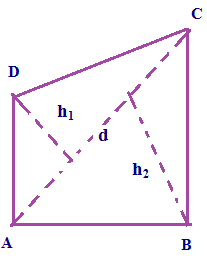In this page area of a quadrilateral we are going to see how to find the area in mensuration. First let us see the formulas to be used to find the area of any quadrilateral then we are going to see example problems and their properties.
Formula:
Area of quadrilateral = (1/2) x d x (h₁ + h₂)
Here d -diagonal
h₁ & h₂ - perpendicular heights
Definition of quadrilateral:
The word quadrilateral can be separated as Quad + lateral. Here quad means four and lateral means sides. A shape which is having four sides is generally called quadrilateral. The shapes parallelogram, rectangle, square, rhombus and trapeziums are one of the type of quadrilateral.
Properties of quadrilateral:
- Sum of interior angles is 360°
- It has four sides
- It has four vertices
Now we are going to some example problems based on these formulas
Example 1:
Find the area of a quadrilateral which is having the diagonal is measuring 50 m and perpendicular height is measuring 10 m and 20 m
Solution:
Area of quadrilateral = (1/2) x d x (h₁ + h₂)
Here h₁ = 10 m, h₂ = 20 m and d = 50 m
Area of quadrilateral = (1/2) x 50 x (10 + 20)
= (1/2) x 50 x 30
= 25 x 30
= 750 m²










